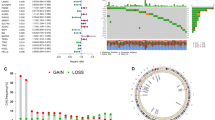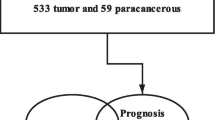Abstract
Purpose
Laryngeal cancer (LC) is a common malignant tumor of the head and neck. However, the relationship between ferroptosis and LC is still unclear. The aim of this study was to identify potential ferroptosis-related biomarkers for diagnosis and prognosis in LC.
Methods
We screened differentially expressed genes (DEGs) related to ferroptosis in LC from the TCGA and FerrDb database. DEGs were identified and enrichment by GO/KEGG, GSEA, GSVA analysis. PPI analysis was performed using String and Cytoscape, then hub genes were extracted. Furthermore, ROC analysis, pan-cancer analysis, gene mutation analysis, immune infiltration correlation analysis and clinical correlation analysis of hub genes were performed.
Results
A total of 59 DEGs were screened, which were more significantly enriched in biological processes and involved in HIF-1 signaling pathway, serotonergic synapse and ferroptosis. A total of 29 significant gene set pathways of LC data were performed by GSEA analysis. The GSVA analysis obtained 53 significant differential gene set pathways. The top 20 genes were identified by PPI. ROC curves revealed four of the top20 genes had a good performance, which were CA9 (AUC = 0.930), MAPK3 (AUC = 0.915), MUC1 (AUC = 0.945), and NOX4 (AUC = 0.933). Subsequent analysis found that CDKN2A has the highest mutation frequency in the top 20 gene, and IFNG had a significant correlation with age, tumor stage, degree of tumor differentiation and lymphatic clearance surgery.
Conclusion
Our study identified key genes closely related to ferroptosis in LC, which still need more studies to explore the mechanisms involved and may become effective clinical diagnostic and prognostic biomarkers.





Similar content being viewed by others
References
Salvador-Coloma C, Cohen E (2016) Multidisciplinary care of laryngeal cancer. J Oncol Pract 12(8):717–724. https://doi.org/10.1200/JOP.2016.014225
Dixon SJ, Lemberg KM, Lamprecht MR et al (2012) Ferroptosis: an iron-dependent form of nonapoptotic cell death. Cell 149(5):1060–1072. https://doi.org/10.1016/j.cell.2012.03.042
Xia Y, Liu S, Li C et al (2020) Discovery of a novel ferroptosis inducer-talaroconvolutin A-killing colorectal cancer cells in vitro and in vivo. Cell Death Dis 11(11):988. https://doi.org/10.1038/s41419-020-03194-2
Wang M, Mao C, Ouyang L et al (2019) Long noncoding RNA LINC00336 inhibits ferroptosis in lung cancer by functioning as a competing endogenous RNA. Cell Death Differ 26(11):2329–2343. https://doi.org/10.1038/s41418-019-0304-y
Liu F, Du J, Liu J et al (2016) Identification of key target genes and pathways in laryngeal carcinoma. Oncol Lett 12(2):1279–1286. https://doi.org/10.3892/ol.2016.4750
Ma J, Hu X, Dai B et al (2021) Bioinformatics analysis of laryngeal squamous cell carcinoma: seeking key candidate genes and pathways. Peer J 9:e11259. https://doi.org/10.7717/peerj.11259
Goldman MJ, Craft B, Hastie M et al (2020) Visualizing and interpreting cancer genomics data via the Xena platform. Nat Biotechnol 38(6):675–678. https://doi.org/10.1038/s41587-020-0546-8
Zhou N, Bao J (2020) FerrDb: a manually curated resource for regulators and markers of ferroptosis and ferroptosis-disease associations. Database (Oxford) 2020. https://doi.org/10.1093/database/baaa021
Ashburner M, Ball CA, Blake JA et al (2000) Gene ontology: tool for the unification of biology. Gene Ontol Consort Nat Genet 25(1):25–29. https://doi.org/10.1038/75556
Kanehisa M, Goto S (2000) KEGG: kyoto encyclopedia of genes and genomes. Nucleic Acids Res 28(1):27–30. https://doi.org/10.1093/nar/28.1.27
Subramanian A, Tamayo P, Mootha VK et al (2005) Gene set enrichment analysis: a knowledge-based approach for interpreting genome-wide expression profiles. Proc Natl Acad Sci USA 102(43):15545–15550. https://doi.org/10.1073/pnas.0506580102
Hanzelmann S, Castelo R, Guinney J (2013) GSVA: gene set variation analysis for microarray and RNA-seq data. BMC Bioinform 14:7. https://doi.org/10.1186/1471-2105-14-7
Szklarczyk D, Gable AL, Lyon D et al (2019) STRING v11: protein–protein association networks with increased coverage, supporting functional discovery in genome-wide experimental datasets. Nucleic Acids Res 47(D1):D607–D613. https://doi.org/10.1093/nar/gky1131
Shannon P, Markiel A, Ozier O et al (2003) Cytoscape: a software environment for integrated models of biomolecular interaction networks. Genome Res 13(11):2498–2504. https://doi.org/10.1101/gr.1239303
Chin CH, Chen SH, Wu HH et al (2014) cytoHubba: identifying hub objects and sub-networks from complex interactome. BMC Syst Biol 8(Suppl 4):S11. https://doi.org/10.1186/1752-0509-8-S4-S11
Robin X, Turck N, Hainard A et al (2011) pROC: an open-source package for R and S+ to analyze and compare ROC curves. BMC Bioinform 12:77. https://doi.org/10.1186/1471-2105-12-77
Newman AM, Liu CL, Green MR et al (2015) Robust enumeration of cell subsets from tissue expression profiles. Nat Method 12(5):453–457. https://doi.org/10.1038/nmeth.3337
Pastorekova S, Gillies RJ (2019) The role of carbonic anhydrase IX in cancer development: links to hypoxia, acidosis, and beyond. Cancer Metastasis Rev 38(1–2):65–77. https://doi.org/10.1007/s10555-019-09799-0
Kwon OJ, Park JJ, Ko GH et al (2015) HIF-1alpha and CA-IX as predictors of locoregional control for determining the optimal treatment modality for early-stage laryngeal carcinoma. Head Neck 37(4):505–510. https://doi.org/10.1002/hed.23620
Bernstein JM, Andrews TD, Slevin NJ et al (2015) Prognostic value of hypoxia-associated markers in advanced larynx and hypopharynx squamous cell carcinoma. Laryngoscope 125(1):E8-15. https://doi.org/10.1002/lary.24933
Schrijvers ML, van der Laan BF, de Bock GH et al (2008) Overexpression of intrinsic hypoxia markers HIF1alpha and CA-IX predict for local recurrence in stage T1–T2 glottic laryngeal carcinoma treated with radiotherapy. Int J Radiat Oncol Biol Phys 72(1):161–169. https://doi.org/10.1016/j.ijrobp.2008.05.025
Wachters JE, Schrijvers ML, Slagter-Menkema L et al (2013) Prognostic significance of HIF-1a, CA-IX, and OPN in T1–T2 laryngeal carcinoma treated with radiotherapy. Laryngoscope 123(9):2154–2160. https://doi.org/10.1002/lary.23831
Hu C, Wang H, Lin L et al (2020) Association between carbonic anhydrase 9 expression and poor prognosis in sinonasal squamous cell carcinoma. Ann Diagn Pathol 49:151643. https://doi.org/10.1016/j.anndiagpath.2020.151643
Li Z, Jiang L, Chew SH et al (2019) Carbonic anhydrase 9 confers resistance to ferroptosis/apoptosis in malignant mesothelioma under hypoxia. Redox Biol 26:101297. https://doi.org/10.1016/j.redox.2019.101297
Wu C, Zhao W, Yu J et al (2018) Induction of ferroptosis and mitochondrial dysfunction by oxidative stress in PC12 cells. Sci Rep 8(1):574. https://doi.org/10.1038/s41598-017-18935-1
Starska K, Forma E, Jozwiak P et al (2016) Gene/protein expression of CAPN1/2-CAST system members is associated with ERK1/2 kinases activity as well as progression and clinical outcome in human laryngeal cancer. Tumour Biol 37(10):13185–13203. https://doi.org/10.1007/s13277-016-5178-8
Sipaul F, Birchall M, Corfield A (2011) What role do mucins have in the development of laryngeal squamous cell carcinoma? Syst rev Eur Arch Otorhinol 268(8):1109–1117. https://doi.org/10.1007/s00405-011-1617-8
Hasegawa M, Takahashi H, Rajabi H et al (2016) Functional interactions of the cystine/glutamate antiporter CD44v and MUC1-C oncoprotein in triple-negative breast cancer cells. Oncotarget 7(11):11756–11769. https://doi.org/10.18632/oncotarget.7598
Jeannon JP, Stafford FW, Soames JV et al (2001) Altered MUC1 and MUC2 glycoprotein expression in laryngeal cancer. Otolaryngol Head Neck Surg 124(2):199–202. https://doi.org/10.1067/mhn.2001.112481
Croce MV, Price MR, Segal-Eiras A (2000) Detection and isolation of MUC1 mucin from larynx squamous cell carcinoma. Pathol Oncol Res 6(2):93–99. https://doi.org/10.1007/BF03032356
Croce MV, Rabassa ME, Price MR et al (2001) MUC1 mucin and carbohydrate associated antigens as tumor markers in head and neck squamous cell carcinoma. Pathol Oncol Res 7(4):284–291. https://doi.org/10.1007/BF03032385
Itoh T, Yonezawa S, Nomoto M et al (1996) Expression of mucin antigens and Lewis X-related antigens in carcinomas and dysplasia of the pharynx and larynx. Pathol Int 46(9):646–655. https://doi.org/10.1111/j.1440-1827.1996.tb03667.x
Croce MV, Rabassa ME, Pereyra A et al (2008) Differential expression of MUC1 and carbohydrate antigens in primary and secondary head and neck squamous cell carcinoma. Head Neck 30(5):647–657. https://doi.org/10.1002/hed.20756
Orcutt KP, Parsons AD, Sibenaller ZA et al (2011) Erlotinib-mediated inhibition of EGFR signaling induces metabolic oxidative stress through NOX4. Cancer Res 71(11):3932–3940. https://doi.org/10.1158/0008-5472.CAN-10-3425
Fletcher EV, Love-Homan L, Sobhakumari A et al (2013) EGFR inhibition induces proinflammatory cytokines via NOX4 in HNSCC. Mol Cancer Res 11(12):1574–1584. https://doi.org/10.1158/1541-7786.MCR-13-0187
Sobhakumari A, Schickling BM, Love-Homan L et al (2013) NOX4 mediates cytoprotective autophagy induced by the EGFR inhibitor erlotinib in head and neck cancer cells. Toxicol Appl Pharmacol 272(3):736–745. https://doi.org/10.1016/j.taap.2013.07.013
Seo SU, Kim TH, Kim DE et al (2017) NOX4-mediated ROS production induces apoptotic cell death via down-regulation of c-FLIP and Mcl-1 expression in combined treatment with thioridazine and curcumin. Redox Biol 13:608–622. https://doi.org/10.1016/j.redox.2017.07.017
Lu S, Wang XZ, He C et al (2021) ATF3 contributes to brucine-triggered glioma cell ferroptosis via promotion of hydrogen peroxide and iron. Acta Pharmacol Sin 42(10):1690–1702. https://doi.org/10.1038/s41401-021-00700-w
Park MW, Cha HW, Kim J et al (2021) NOX4 promotes ferroptosis of astrocytes by oxidative stress-induced lipid peroxidation via the impairment of mitochondrial metabolism in Alzheimer’s diseases. Redox Biol 41:101947. https://doi.org/10.1016/j.redox.2021.101947
Todorova TA, Jordanov SH, Stancheva GS et al (2015) Mutational status of CDKN2A and TP53 genes in laryngeal squamous cell carcinoma. Pathol Oncol Res 21(2):413–421. https://doi.org/10.1007/s12253-014-9836-0
Chen WS, Bindra RS, Mo A et al (2018) CDKN2A copy number loss is an independent prognostic factor in hpv-negative head and neck squamous cell carcinoma. Front Oncol 8:95. https://doi.org/10.3389/fonc.2018.00095
Sanchez Barrueco A, Gonzalez Galan F, Villacampa Auba JM et al (2019) p16 Influence on laryngeal squamous cell carcinoma relapse and survival. Otolaryngol Head Neck Surg 160(6):1042–1047. https://doi.org/10.1177/0194599818821910
Yu ST, Zhou Z, Cai Q et al (2017) Prognostic value of the C-reactive protein/albumin ratio in patients with laryngeal squamous cell carcinoma. Onco Target Ther 10:879–884. https://doi.org/10.2147/OTT.S128391
Xie Y, Zhu S, Song X et al (2017) The Tumor suppressor p53 limits ferroptosis by blocking DPP4 activity. Cell Rep 20(7):1692–1704. https://doi.org/10.1016/j.celrep.2017.07.055
Wang W, Green M, Choi JE et al (2019) CD8(+) T cells regulate tumour ferroptosis during cancer immunotherapy. Nature 569(7755):270–274. https://doi.org/10.1038/s41586-019-1170-y
Funding
The study was financially supported by the National Natural Science Foundation of China (Grant No. 81903983); China Postdoctoral Science Foundation (Grant No. 2019M651122).
Author information
Authors and Affiliations
Contributions
ZJ and ZF design, analysis and interpretation of data. ZJ, ZF and XD statistical analysis; ZF and JW drafting of the manuscript. JW, XW and AY critical revision of the manuscript for important intellectual content, administrative support, obtaining funding, supervision. All authors read and approved the final manuscript.
Corresponding authors
Ethics declarations
Conflict of interest
The authors declare no conflict of interest in the work.
Ethical approval
Ethics approval and patient written informed consent were not required because all analyses in our study were mainly performed based on data from a common database.
Informed consent
Not applicable.
Additional information
Publisher's Note
Springer Nature remains neutral with regard to jurisdictional claims in published maps and institutional affiliations.
Supplementary Information
Below is the link to the electronic supplementary material.






Rights and permissions
About this article
Cite this article
Ji, Z., Fang, Z., Dong, X. et al. Potential ferroptosis-related diagnostic and prognostic biomarkers in laryngeal cancer. Eur Arch Otorhinolaryngol 279, 5277–5288 (2022). https://doi.org/10.1007/s00405-022-07433-4
Received:
Accepted:
Published:
Issue Date:
DOI: https://doi.org/10.1007/s00405-022-07433-4




